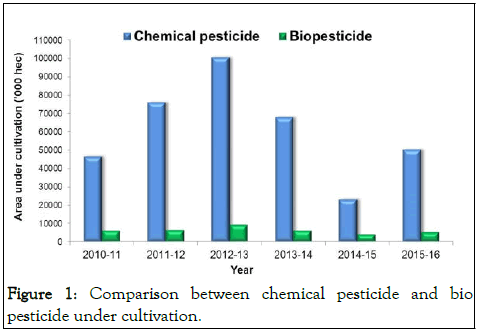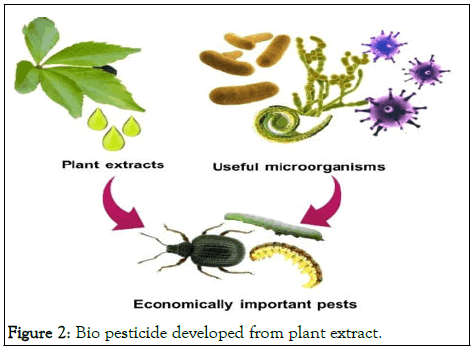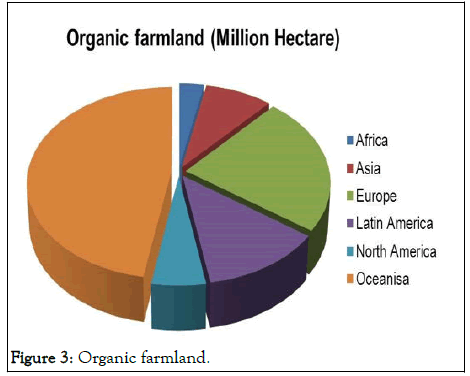Journal of Agricultural Science and Food Research
Open Access
ISSN: 2593-9173
ISSN: 2593-9173
Research Article - (2024)Volume 15, Issue 3
Biopesticide is naturally occurring substances or microorganisms including bacteria, fungus, viruses and nematodes identified for controlling pests through chemical action or by prey-predator and parasite mechanism. They form important component of Integrated Pest Management (IPM) programmes and have received abundant practical attention from large scale to medium farmers and crop protectant industries as a reduced and low risk alternative to chemical crop protectants while maintaining high pest control standards.
Bacteria; Fungus; Biopesticide; Integrated pest management; Chemical crop protectants
In the recent years, extensive focus is being given to organic farming as evident from various government initiatives and boom in organic crop protectant in the market. With states like Sikkim, Mizoram, Uttarakhand and recent addition to this, Himachal Pradesh have now adopting organic route for enhanced and chemical free crops. Thanks to digitation and extensive social media platforms, general public is now more aware about harmful effects of synthetic agrochemicals to humans, other non-target organisms and environment. Biopesticides, derived from nature appeared as an ecofriendly alternative to synthetic chemical pesticides and gaining increasing acceptance globally among farmers, agrochemical companies and government regulators [1].
According to the organic trade association, if every farmer in the U.S. produces organic food, then 500 million pounds of pesticides could be eliminated each year. During the last few years, huge growth in the demand of organic food, especially in the urban and fast-growing markets of India is seen. According to industry analysis, India’s organic food market, presently sized at 6000 crores, is projected to rise at a CAGR of over 25% during the year 2016-2021. The upswing in the per capita purchasing power, appended with increasing consciousness regarding environmental and health benefits of organic products, not only led to the increased demand for such products but also incentivized the development of the organic value chain, as evidenced by continuous developments in industries (Figure 1).

Figure 1: Comparison between chemical pesticide and bio pesticide under cultivation.
Economic feasibility and profitability
Agricultural has always been a risky venture, with irregular weather conditions and unpredictable markets. Anything that can help ease the uncertainty in farming sector is regarded as desirable. Bio pesticides share only small section of the total crop protection market with a value of round $3 billion worldwide, accounting for only 5% of the total crop protection market. The all India statistics on area under use of chemical and biopesticides during 2010-2011 to 2015-2016 showed only slight increase in bio pesticide use in comparison to chemical pesticides [2]. Recently, the market has experienced most significant growth in terms of both sales and user acceptance. It has been estimated that bio pesticides market is projected to reach USD 6. 60 billion by 2022 from USD 3.22 billion in 2017, at a compound annual growth rate of 15.43% globally. This market is primarily driven by the increasing awareness among the people about environmental safety associated with the use of bio pesticides, growing organic farming, increasing demand for organically grown food and emergent government initiatives to encourage the practice of bio pesticides use across the world. Although, the application of bio pesticide is increasing by nearly 10% per year, yet, the global market must rise further in the coming future as these bio pesticides play a vital role in replacing potentially hazardous chemical pesticides and thereby decreasing the current over dependence on them. Globally, by the end of 2016, around 57.8 million hectare farmlands were organically grown over 2015, signifying a growth of 7.5 million hectares, the highest area recorded. Australia is leading with the largest organic agricultural area of 27.2 million hectares, followed by Argentina and China with 3 million hectares and 2.3 million hectares, respectively. Nearly half of the global organic agricultural land is in Oceania accounting for about 27.3 million hectares, followed by Europe and Latin America with 13.5 million hectares and 7.1 million hectares, individually (Figure 2).

Figure 2: Bio pesticide developed from plant extract.
India has enormous prospective for the growth of bio pesticide business as it losses crops of worth USD 9259 million every year due to infestation by various pests. The major companies governing Indian market for bio based products, services and continuous supply are Sri Biotech Laboratories India Ltd., International Panaacea Ltd, Camson Bio Technologies Ltd., Valent Biosciences Corp, Eid Parry, Pest Control India, Excel Crop Care and others. Owing to the presence of higher pesticides residues in food crops and increasing pest resistance, government is posing strict regulations on use of some hazardous synthetic pesticides like organochlorine and organophosphorus class of pesticides, which will encourage the use of bio pesticides in the region [3]. Also, biodegradable and ecofriendly nature of bio pesticides, positive and increasing public awareness, environmental safety and constantly developing pesticide resistance are the key factors governing the growth of the market.
The implication of bio pesticides in IPM system has also gained enormous popularity in India. Bio pesticides benefit progressive traders and offers a broad range of crop protection and oblige consumers with growing technology. To date, more than 950 bio pesticides are present in the Indian market registered by the Central Insecticides Board and Registration Committee (CIB and RC), but quality and efficacy of these products is a major challenge. Presently, 90% of the market is occupied by Bacillus thuringiensis (Bt), Trichoderma sp., Beauveria sp., Metarhizium sp. and Paecilomyces spp. based bio-agrichemicals. Microbial consortia based multifaceted formulations with varied potentials could help bringing down the cost. Bio pesticides consortia will have holistic applicability in protecting plant against devastating pests, strengthening plant microbe interactions and promoting plant growth. The bio pesticide industry will enjoy a long term positive impact in terms of government policies and promising domestic and overseas market environment will further endorse the development of this sector. Furthermore, collaboration between the public and private sectors is necessary to facilitate the manufacturing, growth and sale of these environment friendly substitutes. In this perspective, development of new ingredients and research on formulation and delivery would enhance commercialization and application of bio pesticides. Quality products along with ability to perform under field conditions will be able to contend with the synthetic pesticides and can gradually overtake the market. Although a lot of research is being undertaken for innovative and efficacious bio pesticide development, but still further progress is required to make it popular and acceptable by the farmers’ community [4]. This could be achieved by making robust policy and encouragement from government to the various stakeholders as well as end user. Building awareness among the end users about the beneficial effects of bio pesticides and dangers associated chemical protectants will definitely build a congenial and longlasting effect which can lead to commercial triumph of the bio pesticides (Figure 3).

Figure 3: Organic farmland.
Government boost and regulatory ease
Bio pesticides are being applied globally; developed nations are ahead in their application. On the other hand, in India farmers are confused and not confident in selecting bio pesticides over the chemical protectants. Although, developing countries like India has a huge potential for using bio pesticides as our economy is still largely agriculture dependent and availability of cheap labor bring down the production cost in comparison to developed nations. In India, the ministry of agriculture and the department of biotechnology play significant role for promoting bio pesticides, under the Integrated Pest Management (IPM) approach. Several promising efforts have been made to integrate bio pesticides in a sustainable system competitive with chemical crop protectants and production techniques. Various packages and processes for management of pests and diseases in crops have been revised to include measures to reduce dependence on synthetic pesticides and embolden the use of bio pesticides and other safe and natural alternative plant protectants. Further, the registration constraint for bio pesticides has been simplified to encourage introduction of more bio pesticides in the market. Also, central government offers grant-in-aid of Rs.45 lakhs for construction and Rs. 20 lakhs for procuring equipment’s required for setup of biocontrol laboratories for large scale production of bio pesticides to state governments. Apart from this, Rs. 20 lakh grants-in-aidis also provided by state governments for procuring equipment’s required for setting up bio pesticides testing laboratories. Farmers are being regularly trained by the farmer’s field schools organized by the support of Central Integrated Pest Management Centers (CIPMCs) about the identification and preservation techniques of several beneficial predators like lady bird beetles, spiders, chrysopa and other predatory fauna present in agro ecosystem and are directly involved in natural pest control [5].
The recently published report by the Food and Agriculture Organization (FAO) of the United Nations has cautioned of severe loss of biodiversity that contribute to food production. The report also highlights the damage caused to biological control agents including insects and pests as a key factor in falling biodiversity. In India a constant decline in the population of parasitoid wasps and parasitoid flies, which play an important role in biological pest control, was seen over the years. Consequently, there is an urgent need for restoring biological strata. The application of biological in agriculture as bio fertilizers and bio pesticides helps in restoring damaging biodiversity. The Government needs to step up its strategies to daunt the use of chemical fertilizers and pesticide by encouraging the use bio fertilizers and bio pesticides. Department of agriculture, co-operation and farmer’s welfare, DAC and FW promotes IPM techniques which encourage cultural, biological and mechanical methods of pest control and supports judicious and need based use of pesticides. Further, the scheme “Strengthening and modernization of pest management approach in India” have been implemented by DAC and FW to promote IPM based on ecofriendly methodology for managing pest problems.
It includes safe pest control measures such as mechanical, cultural and biological with least dependence on synthetic pesticides. The supporting regulatory policies and escalating market environment, encouraging Indian companies for exerting their full capacity to grab the market opportunities [6].
Health and safety
Bio pesticides offers a unique and innovative methodology for the management of economically important pests, by formulated natural extracts or exploring microbial agents as an active ingredient. Over the years, due to excessive and non-judicious use of chemical pesticides and considering their harmful impact on human health and environmental, there has been a resurgence of attention in discovering the potentials of bioactive for combating devastating pests. Bio pesticides offers lower risk for the consumers and are inherently less toxic than conventional pesticides and affect only target pests in comparison to broad spectrum, persistent conventional synthetic pesticides that generally affect other non-target organisms including birds, amphibians, economically important insects like bees and mammals. Bio-agrochemicals not reported to show any major harmful effects on human health, however, in some cases, the spore of biocontrol fungi including Trichoderma, M. anisopliae and B. bassiana may cause allergy to workers. Therefore, strain monitoring is absolutely necessary before developing any bio pesticide. Utmost care should be taken to ensure that newly introduced bio based product, should possess no threat to the workers, environment and end consumer before it is presented into crop protection schemes [7]. The enormously successful Bt-based bio pesticides are not reported to show any adverse effects on human health. The occupational hazards associated with preparation bio pesticide formulations are negligible in comparison to potentially dangerous synthetic pesticides. Also, bio pesticides are effective in very small quantities and often decompose rapidly, ensuing lower exposures and environmental persistence caused by traditional pesticides. To promote organic farming and endorsement of biological crop protectants “grow safe food” movement has been introduced to create awareness regarding the safe and judicious use of pesticides among several stakeholders. In addition, DAC and FW has reviewed several IPM practices for major economic crops giving boost to biological and cultural techniques of pest control.
Resource use efficiency
Bio pesticides are drawing enormous attention globally as safer stratagem to control pest populations accompanied with reduced risk to humans, environment and other non-target organisms. Every year the number of marketed bio pesticide products is increasing, however there is an urgent need to empower farmers to get the best out of each product [8]. The bio pesticides are not stand-alone product but work best as an IPM component. In India most of the growers are not aware about potentials of bio pesticide and its application, most farmers depend on shopkeepers for information on pesticide use and application. The cultivators need to be made aware and supported for adopting bio pesticide and IPM tools.
The important factors governing the Indian bio agriculture market includes escalating food demand for continuously growing population, regulatory ease and end-user focus on sustainable agriculture, increasing health awareness and climbing demand of organic products, etc. The practical challenges for enhancing bio pesticide use efficiency includes: (i) improvements in the inherent efficacy of specific products together with higher potency, superior and consistent quality and lengthier persistence of effect considering thermal tolerance, humidity and timing of application, (ii) unique and targeted delivery systems, (iii) compatibility of bio pesticides with other crop protection agents and (iv) better execution along with farmers’ awareness. Profit in bio pesticide industry could be generated by employing novel tools and techniques for producing bio based products. Agroindustry need to develop innovative techniques and search for low-cost raw material to capture market shares by offering innovative products to the cultivators.
Potential partners
In the coming years, government is likely to continue promoting organic forming by introducing more farmer and stakeholder encouraging schemes [9]. This will help to generate a practical opportunity for bio pesticide companies and stakeholders to fill the gap. The bio agriculture industry is represented by several stakeholders, including researchers, regulators, manufacturers, dealers and consumers that are involved in the expansion, popularization and commercialization of bio based products. In India the major players in bio pesticide business are Biotech International Ltd, Hindustan Insecticide Ltd, Rallis India Ltd, Pest control India Ltd, International Panacea Ltd, Sun Agro Industries, Crop Health Products Ltd, J.R. Biocontrol Laboratories, Prathista Industries Ltd, Insecticides India Ltd. etc. Several research and academic organizations like Indian council of agricultural research, state agricultural universities, nongovernment organizations and other educational institute are actively involved in the innovative development and promotion of bio agrochemicals. The Energy and Resources Institute (TERI), is devoted for developing innovative and sustainable solutions to address current challenges in the field of agriculture and environment and is involved from the earliest stages of the development and R and D processes. Several bio agrochemicals including mycorrhiza based bio fertilizers, Plant Growth Promoting Rhizobacteria (PGPR’s) and bio pesticide like bollcure has been successfully developed and commercialized by TERI. TERI holds promising potential for developing new and innovative solution for boosting sustainable agriculture and organic farming from lab to land [10].
Nano bio pesticides: Next generation bio pesticide
India’s ‘Vision 2050’ for increasing agricultural productivity stimulates new technology driven interventions and endorse greater capacity-building and R and D in the area. Nanotechnology has transformed the world with marvelous advancements in many areas like electronics, information and technology, biotechnology, chemistry and agriculture. The application of nanotechnology to boost agricultural output has been well recognized.
The small sized engineered nanostructures help slash the amount of active ingredient being applied in the field. Their higher total surface area and shelf-life allows better dispersion and adhesion of bioactive thereby resulting in improved interaction with pests as compared with their conventional non-nanocounterparts. These nanostructures can also be engineered for controlled and targeted release of active ingredients without affecting beneficial organisms. As presented earlier, bio pesticides offer novel potential in sustainable crop protection and presents many advantages over conventional synthetic pesticides. However, their inability to withstand changing environmental conditions like temperature, humidity, sunlight, low persistence and limited shelf life offers a great challenge in improving their performance. Also, conventional techniques such as encapsulation, spray drying, ball milling etc. are not suitable methods for processing certain bio pesticides particularly those based on microorganisms. These drawbacks associated with conventional techniques can successfully be accomplished by nanotechnological intervention which offers efficient and sustainable alternatives for the management of economically important pests in agriculture. Several polymeric nanobiopesticides like neem (Azadirachta indica), based colloidal nanoformulations, essential oils like garlic oil, neem oil, thymol, eugenol loaded nanoformulations, nanoemulsions of water insoluble active ingredients like rotenone, pheromone nanogels, nanoencapsulation, biogenic metallic nanoparticles like silver (AgNPs), zinc oxide (ZnO) etc. have been well studied for their pesticidal efficacy [11].
Over the years, traditional pest management strategies are constantly being upgraded owing to the increasing potentials of nanotechnology as an effective, ecofriendly and practical approach to assuage problems pertaining to pest control. The advancement in the research and development of nanobiopesticides is still in its infancy but is progressing continuously. Better understanding of the mode of action at nanoscale, their effects and regulatory concerns help further to promote nanobiopesticides profile among the farmers and policy makers and thereby empower them to contribute toward sustainability.
[Crossref] [Google Scholar] [PubMed]
[Crossref] [Google Scholar] [PubMed]
[Crossref] [Google Scholar] [PubMed]
[Crossref] [Google Scholar] [PubMed]
[Crossref] [Google Scholar] [PubMed]
[Crossref] [Google Scholar] [PubMed]
Citation: Pandey A, Adholeya A (2024) Biopesticides: Boon for Industries and Organic Farmers in India. J Agri Sci Food Res. 15:182.
Received: 10-Dec-2019, Manuscript No. JBFBP-23-2895; Editor assigned: 13-Dec-2019, Pre QC No. JBFBP-23-2895 (PQ); Reviewed: 27-Dec-2019, QC No. JBFBP-23-2895; Revised: 02-Jul-2024, Manuscript No. JBFBP-23-2895 (R); Published: 30-Jul-2024 , DOI: 10.35248/2593-9173.24.15.182
Copyright: © 2024 Pandey A, et al. This is an open-access article distributed under the terms of the Creative Commons Attribution License, which permits unrestricted use, distribution, and reproduction in any medium, provided the original author and source are credited.